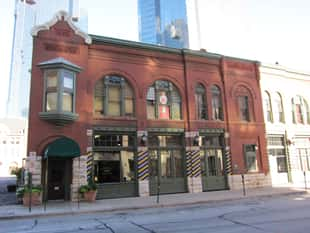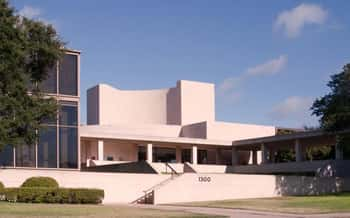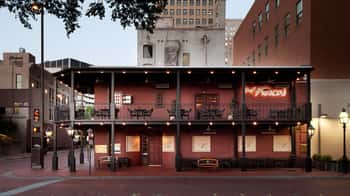This Fort Worth landmark on the shores of Lake Worth was originally named after a famous Scottish castle. Especially in its present dilapidated state, it certainly looks the part of a haunted house...do the spirits agree?
Since the 19th century, people claim to have seen a woman in a white dress running from the property to the edge of Lake Worth, then vanishing. Some claim to see this same woman in white standing in various windows around the property.
More recently, the phantom of a handsome young man, often dressed in black, has been spotted. He’s sometimes only a shadow and seems to stare visitors down from a distance. Some believe the property is cursed, and they may be right.
Who are these lost spirits haunting the grounds of the Castle of Heron Bay?
The story of the Castle of Heron Bay begins in 1860. We’re not sure who owned the land as all records were lost in a fire, but we know that he built a stone farmhouse on the property. Apparently, he’d intended it to be a wedding gift to his betrothed.
However, on the day they were to be married, the man made a tragic discovery. He found his bride-to-be face down, drowned near the shore of Lake Worth. To this day, her death is a mystery. Was it suicide? Did someone not approve of their marriage?
Just one month later, that man married the drowned woman’s sister. Not long after that, locals began telling of a woman in a white dress running from the property towards the lake, then vanishing. No doubt, this was the spirit of the drowned bride, but why is she running?
Others report seeing this phantom in the house itself. One former owner of the castle recounted being awoken one night by a strange noise. When he opened his eyes, he saw a female apparition, draped in a white gown, hovering right above him.
The “Woman in White” is known to be a fairly common haunting. These spirits, especially those tied to a wedding, are typically not vengeful. Though the ghostly sight of the Woman in White might cause a fright, she’s unlikely to cause any harm.
Carmen Montoya lived near the Castle of Heron Bay with her husband. They’d occasionally stop by the castle and take in the serene atmosphere. One day, she spotted what she thought was a young man in one of the windows of the uninhabited structure.
Oh my God, look!
, Carmen exclaimed to her husband. By the time they both turned around and looked at the window, there was nothing there. Carmen admitted It could have just been my nerves
, but insisted she wouldn’t visit the property anymore.
Numerous other visitors claim to have seen the same young man
, usually through the castle’s windows. Most seem to think it’s the shade of the son of a previous owner, said to have ended his own life on the property.
Whatever the case, there’s definitely something spooky about the Castle of Heron Bay. It’s rumored to be the site of multiple tragedies, and several fires which have left it mostly unoccupied since the late 1970s. Is it possible that the property is cursed?
After the wedding day tragedy which seems to have occurred in 1860, what records we have don’t tell us much. There are a few names listed as having owned the property, but very little information about them survives. It was sold to the city of Fort Worth by then-owner Oliver S. Kennedy in 1911.
From there it fell into the hands of a Mr. McPherson, a wealthy Irish builder. He began adding on to the original stone structure, importing stone and furnishings from Europe in the process. McPherson’s additions are probably the main reason why the building looks so much like a castle to this day.
McPherson either grew tired of the property or had a nasty gambling addiction, as at some point he staked the property in a game of poker and lost it. The beneficiary of this blunder was Samuel Whiting, a Canadian by birth. Mr. Whiting would finish building the castle, and for many years it would be known as the Whiting Castle.
Although locals knew the building as the Whiting Castle, Samuel and his family called it Inverness, after a famous castle in Scotland. That Inverness lies along the Ness River, of Loch Ness fame (more on that later).
The Whiting family had been living in Utah for some time. After the death of their second son Richard at age 5, they were looking for a fresh start and settled into the Fort Worth area. Their bad luck would follow them.
The building was allegedly used as a gambling hall and speakeasy during Prohibition. It’s difficult to verify, but there did appear to be a secret passageway that ran to the shore of Lake Worth. Rumor has it that this tunnel was used to get alcohol into the Castle, and could double as an escape route.
Not long after completing construction in 1938, the building suffered a fire. The full extent of the damage isn’t clear, but it seems to have required some serious work to repair. From around 1944 to 1954 it was leased to the Vultee Aircraft Corporation, which used it as a private club and getaway for visiting dignitaries. Notably, Dwight D. Eisenhower and James Stewart briefly stayed on the premises.
Details of the full list of occupants are murky at best: one woman, claiming to be Samuel Whiting’s granddaughter, says she lived there from 1941 through the years when it was leased to Vultee. What we can say for sure is that Samuel himself died in 1951, and just two years later, tragedy would strike again.
In 1953, the body of John C. Whiting, Samuel’s first son, was found lifeless, still holding the 22 caliber pistol with which he ended his life. This came just a week after his second wife won a divorce suit against him citing cruel treatment
.
John was no young man at the time. He was a very depressed 44-year-old insurance salesman. He also didn’t die at the Castle, but rather in a house he owned some 3 miles from the property. How, then, does this tie into reports of a “young man” haunting the Castle?
It’s reasonably likely that John Whiting lived at the castle during his adolescent or teenage years, even his early 20s. He got to live the awesome fantasy of growing up in a castle, one that reportedly had a secret passageway used for smuggling booze during the prohibition years. He easily could’ve become attached to the Whiting Castle.
At the time of John’s death, he was a twice-divorced middle-aged insurance salesman. His childhood years were like a fantasy. As he aged, he must’ve pined for those enchanted younger years. This writer doesn’t doubt that John’s soul, upon his passing, might have reverted to a time and place where he was happy.
John’s death wouldn’t be the last connected to the Castle of Heron Bay. In 1963, Karen Beck was renting a room in the castle. She had been separated from her husband for 18 months, though not yet officially divorced.
Karen’s brother found her dead in her castle apartment. There were some signs of a struggle: bits and bobs were strewn about, some furniture was overturned and the commode had been pulled away from the wall.
Karen, however, had no cuts or bruises on her. Ultimately the death was ruled natural, resulting from pneumonia. Still, we can’t help but wonder about the mysterious circumstances around her death, and whether or not it’s indicative of some sort of curse on the Castle of Heron Bay.
As mentioned previously, the Whitings named their home on Lake Worth Inverness
after a Scottish castle of the same name. Inverness lies on the River Ness which runs between Loch Ness and the North Sea. I don’t think I need to mention that Loch Ness is famous around the world for sightings of Nessie, or the Loch Ness Monster
.
Could it be a coincidence then, that in 1947, citizens of the Lake Worth area began reporting that they saw a large sea monster in the lake? It was described much like Nessie: a dark figure, with a long neck, protruding several feet from the water’s surface, then ducking back below view. The creature was dubbed the Lake Worth Monster.
Turns out, this was just a prank pulled by a local business owner, trying to drum up business. He used an ingenious system of pulleys, anchored by rocks in the lake, to make a tire innertube rise and fall in the lake at will. But that wasn’t the last we’d hear of the monster…
In 1969, there were reports of a tall, humanoid beast with the head of a goat living on an island in Lake Worth. This became the new Lake Worth Monster. Word of the monster spread all the way to soldiers in Vietnam, writing to loved ones, asking for updates on the beast’s activities.
This, too, turned out to be a hoax. The legend, however, never died. Local Writer Sallie Ann Clarke wrote a children’s’ book about the beast. In 1975, playwright Johnny Simons wrote a play chronicling the lonely beast’s search for love (he is eventually united with Nessie). It’s possible that all of this was inspired by the connection between the Castle of Heron Bay and Scotland’s Inverness.
In 1982, Larry Keith Robison went on a killing spree just one mile east of the Castle of Heron Bay. Larry was a paranoid schizophrenic whose mother had repeatedly tried to get him treatment for his mental health issues.
Larry first slaughtered his roommate, decapitating him before moving to the house next door. There, he stabbed three members of the family to death. When the 4th arrived later, Larry killed him too.
Robison fled to Kansas, where he was later found sleeping in his car and arrested. He sat on death row from his 1983 sentencing until his execution in 2000. His case was highly publicized in its later years, sparking discussion over how mentally ill criminals should be treated, especially concerning capital punishment.
You can check out the Castle of Heron Bay, if you dare, at 9115 Heron Drive in Fort Worth. The property is fenced off, so you can’t get too close. If you go in late fall or during the winter, it can be serenely beautiful, with long, wispy, yellow grass dancing in the breeze, and the waters of Lake Worth gently lapping at the shore.
As for whether or not the Castle is cursed - who’s to say? We’ll let you decide for yourselves.

It’s a building that will stop you in your tracks in downtown Fort Worth.

Built in 1966 by the Scott Foundation, this 468-seat theatre is crawling with poltergeists.

If you’re visiting Fort Worth, this steakhouse is known for their bloodier fare.